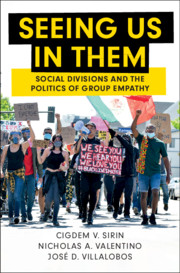Book contents
- Seeing Us in Them
- Cambridge Studies in Public Opinion and Political Psychology
- Seeing Us in Them
- Copyright page
- Dedication
- Contents
- Figures
- Tables
- Prologue
- 1 The Puzzle
- 2 Group Empathy Theory
- 3 Measuring Group Empathy
- 4 An Origin Story
- 5 Group Empathy and Homeland Security
- 6 Group Empathy and the Politics of Immigration
- 7 Group Empathy and Foreign Policy
- 8 Group Empathy in the Era of Trump
- 9 Group Empathy, Brexit, and Public Opinion in the United Kingdom
- 10 Cultivating Group Empathy and Challenging Ethnonationalist Politics
- Epilogue Group Empathy in Response to the COVID-19 Pandemic
- References
- Index
- Books in the series
6 - Group Empathy and the Politics of Immigration
Published online by Cambridge University Press: 11 March 2021
- Seeing Us in Them
- Cambridge Studies in Public Opinion and Political Psychology
- Seeing Us in Them
- Copyright page
- Dedication
- Contents
- Figures
- Tables
- Prologue
- 1 The Puzzle
- 2 Group Empathy Theory
- 3 Measuring Group Empathy
- 4 An Origin Story
- 5 Group Empathy and Homeland Security
- 6 Group Empathy and the Politics of Immigration
- 7 Group Empathy and Foreign Policy
- 8 Group Empathy in the Era of Trump
- 9 Group Empathy, Brexit, and Public Opinion in the United Kingdom
- 10 Cultivating Group Empathy and Challenging Ethnonationalist Politics
- Epilogue Group Empathy in Response to the COVID-19 Pandemic
- References
- Index
- Books in the series
Summary
Chapter 6 examines the effect of group empathy on public reactions to undocumented immigration. Results from a national survey experiment demonstrate that group empathy is significantly linked to attitudes about undocumented immigrants, even after controlling for other predispositions including partisanship, ideology, social dominance orientation (SDO), immigration threat, and more. While the significant effects of group empathy apply to all racial/ethnic groups, we find that minorities display higher levels of group empathy than whites do, which in turn lead to more favorable views of undocumented immigrants. Our experimental findings further reveal substantial intergroup differences in reactions to white versus non-white immigrants. African Americans and Latinos were far more likely to side with immigrant detainees in distress of all races/ethnicities and were also more supportive of pro-civil rights policies and actions compared to whites. African Americans were far more likely to take the side of an immigrant if he/she was nonwhite. Latinos, likely because they view the issue as more relevant to their group, were strongly opposed to punitive actions and policies regardless of the race/ethnicity of the immigrant. Finally, we confirm that differences in group-based empathic reactions help explain these racial/ethnic gaps in political attitudes and behavior concerning undocumented immigration.
Keywords
- Type
- Chapter
- Information
- Seeing Us in ThemSocial Divisions and the Politics of Group Empathy, pp. 110 - 134Publisher: Cambridge University PressPrint publication year: 2021

